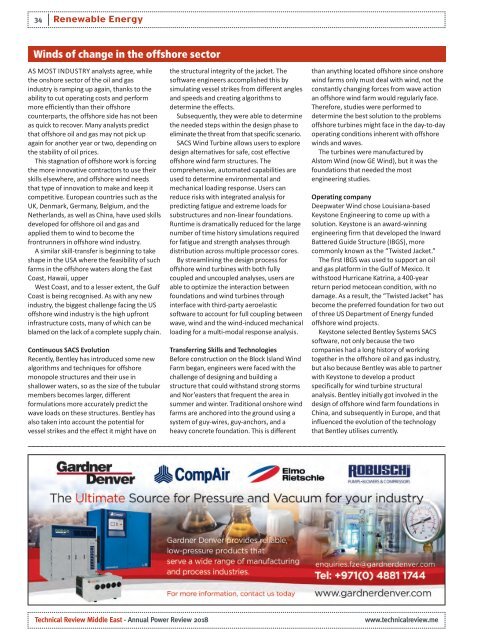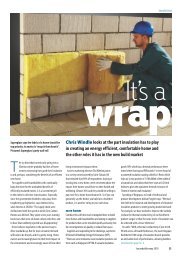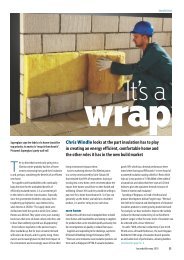TRME_4_2018
Technical Review Middle East
Technical Review Middle East
You also want an ePaper? Increase the reach of your titles
YUMPU automatically turns print PDFs into web optimized ePapers that Google loves.
34 Renewable Energy<br />
Winds of change in the offshore sector<br />
AS MOST INDUSTRy analysts agree, while<br />
the onshore sector of the oil and gas<br />
industry is ramping up again, thanks to the<br />
ability to cut operating costs and perform<br />
more efficiently than their offshore<br />
counterparts, the offshore side has not been<br />
as quick to recover. Many analysts predict<br />
that offshore oil and gas may not pick up<br />
again for another year or two, depending on<br />
the stability of oil prices.<br />
This stagnation of offshore work is forcing<br />
the more innovative contractors to use their<br />
skills elsewhere, and offshore wind needs<br />
that type of innovation to make and keep it<br />
competitive. European countries such as the<br />
UK, Denmark, Germany, Belgium, and the<br />
Netherlands, as well as China, have used skills<br />
developed for offshore oil and gas and<br />
applied them to wind to become the<br />
frontrunners in offshore wind industry.<br />
A similar skill-transfer is beginning to take<br />
shape in the USA where the feasibility of such<br />
farms in the offshore waters along the East<br />
Coast, Hawaii, upper<br />
West Coast, and to a lesser extent, the Gulf<br />
Coast is being recognised. As with any new<br />
industry, the biggest challenge facing the US<br />
offshore wind industry is the high upfront<br />
infrastructure costs, many of which can be<br />
blamed on the lack of a complete supply chain.<br />
Continuous SACS Evolution<br />
Recently, Bentley has introduced some new<br />
algorithms and techniques for offshore<br />
monopole structures and their use in<br />
shallower waters, so as the size of the tubular<br />
members becomes larger, different<br />
formulations more accurately predict the<br />
wave loads on these structures. Bentley has<br />
also taken into account the potential for<br />
vessel strikes and the effect it might have on<br />
the structural integrity of the jacket. The<br />
software engineers accomplished this by<br />
simulating vessel strikes from different angles<br />
and speeds and creating algorithms to<br />
determine the effects.<br />
Subsequently, they were able to determine<br />
the needed steps within the design phase to<br />
eliminate the threat from that specific scenario.<br />
SACS Wind Turbine allows users to explore<br />
design alternatives for safe, cost effective<br />
offshore wind farm structures. The<br />
comprehensive, automated capabilities are<br />
used to determine environmental and<br />
mechanical loading response. Users can<br />
reduce risks with integrated analysis for<br />
predicting fatigue and extreme loads for<br />
substructures and non-linear foundations.<br />
Runtime is dramatically reduced for the large<br />
number of time history simulations required<br />
for fatigue and strength analyses through<br />
distribution across multiple processor cores.<br />
By streamlining the design process for<br />
offshore wind turbines with both fully<br />
coupled and uncoupled analyses, users are<br />
able to optimize the interaction between<br />
foundations and wind turbines through<br />
interface with third-party aeroelastic<br />
software to account for full coupling between<br />
wave, wind and the wind-induced mechanical<br />
loading for a multi-modal response analysis.<br />
Transferring Skills and Technologies<br />
Before construction on the Block Island Wind<br />
Farm began, engineers were faced with the<br />
challenge of designing and building a<br />
structure that could withstand strong storms<br />
and Nor’easters that frequent the area in<br />
summer and winter. Traditional onshore wind<br />
farms are anchored into the ground using a<br />
system of guy-wires, guy-anchors, and a<br />
heavy concrete foundation. This is different<br />
than anything located offshore since onshore<br />
wind farms only must deal with wind, not the<br />
constantly changing forces from wave action<br />
an offshore wind farm would regularly face.<br />
Therefore, studies were performed to<br />
determine the best solution to the problems<br />
offshore turbines might face in the day-to-day<br />
operating conditions inherent with offshore<br />
winds and waves.<br />
The turbines were manufactured by<br />
Alstom Wind (now GE Wind), but it was the<br />
foundations that needed the most<br />
engineering studies.<br />
Operating company<br />
Deepwater Wind chose Louisiana-based<br />
Keystone Engineering to come up with a<br />
solution. Keystone is an award-winning<br />
engineering firm that developed the Inward<br />
Battered Guide Structure (IBGS), more<br />
commonly known as the “Twisted Jacket.”<br />
The first IBGS was used to support an oil<br />
and gas platform in the Gulf of Mexico. It<br />
withstood Hurricane Katrina, a 400-year<br />
return period metocean condition, with no<br />
damage. As a result, the “Twisted Jacket” has<br />
become the preferred foundation for two out<br />
of three US Department of Energy funded<br />
offshore wind projects.<br />
Keystone selected Bentley Systems SACS<br />
software, not only because the two<br />
companies had a long history of working<br />
together in the offshore oil and gas industry,<br />
but also because Bentley was able to partner<br />
with Keystone to develop a product<br />
specifically for wind turbine structural<br />
analysis. Bentley initially got involved in the<br />
design of offshore wind farm foundations in<br />
China, and subsequently in Europe, and that<br />
influenced the evolution of the technology<br />
that Bentley utilises currently.<br />
Technical Review Middle East - Annual Power Review <strong>2018</strong><br />
www.technicalreview.me







